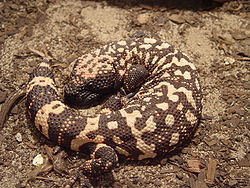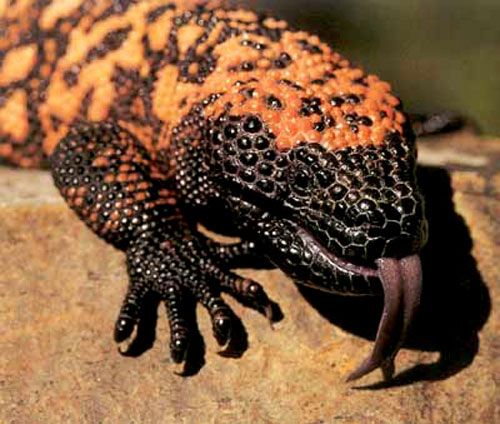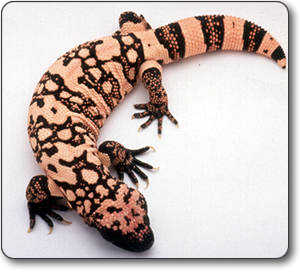Gila Monsters Invade Utah
Posted by: Loren Coleman on May 21st, 2009
Gila monster (Heloderma suspectum)
There are monsters in Utah, and if you don’t watch out, one of them may sneak up on you in St. George. But experts say their dangerous reputation is a bit overrated.
The monster recently invaded southern Utah was a Gila monster. They’re rarely seen in the state, but this one walked up to a clothing store in St. George and scared some landscapers.
“Unrealistically [scared them], I guess. I mean, they’re only aggressive if you poke at them,” said Patrick Emblidge, biologist with the Utah Division of Wildlife Resources.
Emblidge is working on a masters degree in Gila monsters, so he’s a fan. But he doesn’t deny their venom packs a punch that’s both bad and good. He says a bite results in extreme pain and increased memory function.
Improved trivia skills and a treatment for diabetes developed from their venom. “They make it synthetically now, but it’s really an incredible symbol of the value of bio-diversity,” Emblidge said.
But let’s get real: they’re called Gila monsters because they’re dangerous, right?
“There’s very, very few confirmed human fatalities. And the most recent one was like 50, 60 years ago. It was an old drunk guy poking at a Gila monster, so it bit him,” Emblidge said.
They are elusive, rarely seen; preferring to hide under rocks. “Populations have seemed to decrease pretty dramatically in the last 20 to 30 years,” Emblidge said.
Ironically, people are seeing them more and more in St. George. “The houses are sprawling out into really good habitat and kind of displacing a lot of the Gila monsters that were already there,” Emblidge explained.
If you insist on being scared of them, here’s a fact that will help: Emblidge says one meal can be up to one-third of their body mass. It’s like a 100-pound person eating a 33-pound meal in one sitting.
But here’s the reassuring part: They don’t eat three square meals a day. It’s more like three a year.
The Gila monster captured at the clothing store was released into the wild at the Red Cliffs Desert Reserve*.
*The Red Cliffs Desert Reserve spans across the north central portion of Washington County in southwest Utah. The Reserve is approximately 20 miles wide and 6 miles deep. The Reserve is northerly of Ivins, Santa Clara, St. George and Washington City, south of Leeds, and westerly of Hurricane and LaVerkin. The Reserve is trisected by Highway 18 in the west and I-15 in the east.
🙂 Thank You.
About Loren Coleman
Loren Coleman is one of the world’s leading cryptozoologists, some say “the” leading living cryptozoologist. Certainly, he is acknowledged as the current living American researcher and writer who has most popularized cryptozoology in the late 20th and early 21st centuries.
Starting his fieldwork and investigations in 1960, after traveling and trekking extensively in pursuit of cryptozoological mysteries, Coleman began writing to share his experiences in 1969. An honorary member of Ivan T. Sanderson’s Society for the Investigation of the Unexplained in the 1970s, Coleman has been bestowed with similar honorary memberships of the North Idaho College Cryptozoology Club in 1983, and in subsequent years, that of the British Columbia Scientific Cryptozoology Club, CryptoSafari International, and other international organizations. He was also a Life Member and Benefactor of the International Society of Cryptozoology (now-defunct).
Loren Coleman’s daily blog, as a member of the Cryptomundo Team, served as an ongoing avenue of communication for the ever-growing body of cryptozoo news from 2005 through 2013. He returned as an infrequent contributor beginning Halloween week of 2015.
Coleman is the founder in 2003, and current director of the International Cryptozoology Museum in Portland, Maine.













Wow
Increased memory and treatment for diabetes. That is actually rather amazing, but I can’t help but wonder how, exactly, they figured that out. Especially if there haven’t been many victims lately.
I know urban sprawl is over all a bad thing, but I have to wonder what else we’ll find as they clear land for more houses.
“He says a bite results in extreme pain and increased memory function.”
If a critter like that bit me, I sure as heck would remember it for the rest of my life!
PS: I’m sure I’m not the only one who finds interesting the fact that such “dragons” are to be found in a place called St. George 🙂
A very impressive lizard and they actually tame quite well and can be handled with relative safety in time. Of course, that is if you possess the appropriate federal and state permits. They do not inject venom into prey like a rattlesnake. They hold on and chew and the venom flows down groves in the teeth into the wound.
Like the vast majority of animals, Gilas will flee if they get the chance. They are really only dangerous if you corner and harass it or try to pick it up. I am surprised that if the housing developments are taking up “prime habitat” the Endangered Species Act has not invoked or other measures taken to limit the development.
If any of you want a good laugh, get a copy of The Giant Gila Monster, black & white – 1959. The Mystery Science Theater 3000 version is superb. You will marvel at the 50s hairdos, hot rods and rock & roll and how people cannot see a 50 foot long lizard coming down the road until it is right on top of them. 🙂
Gila monsters are not going to attack anyone because they are hungry. Even if they did need three squares a day, humans are simply too big to be considered a prey item. A person is more likely to be bit if they actively provoke the creature. As Alligator said, they are more likely to flee than try to take on a human.
Another point to consider is that the venom delivery system of Gila monsters is not particularly efficient. Unlike snakes, which forcibly inject venom directly into their prey, Gila monsters lack the musculature to do this. In addition, the venom producing salivary glands of Gila monsters are found in the lower jaw as opposed to the venom sacks in the upper jaw of snakes. So Gila monsters basically have to get a good grip on its target and gnaw on it for a bit in order to open a wound for the venom to flow into. Considering the venom producing region is in the lower jaw, they often have to roll over so that gravity can help get the venom into the wounds.
Not incredibly efficient, and most likely a defensive adaptation rather than an offensive one used for nabbing prey. You could feasibly get bitten by a Gila monster and not suffer any effects of venom at all.
Excellent points there mystery-man. Needless to say, to get “bit” by one, you’ve got to either be picking it up or putting your hand darn close to it when its cornered.